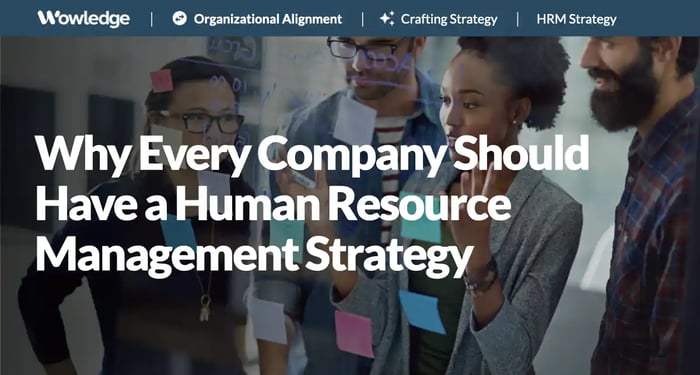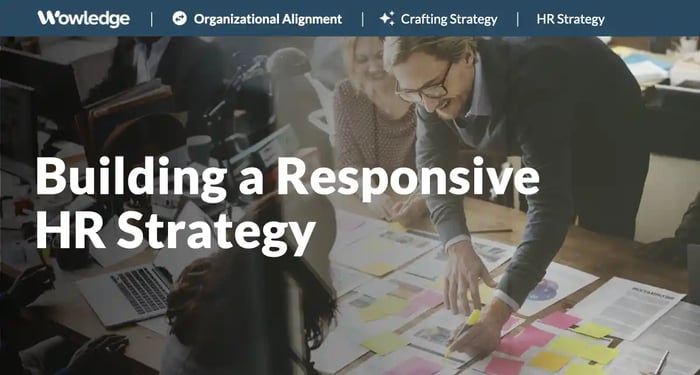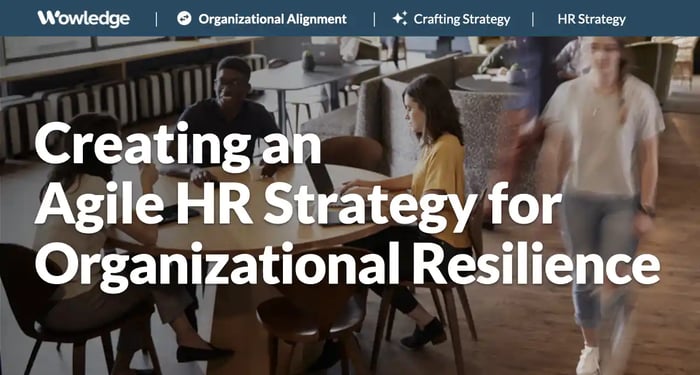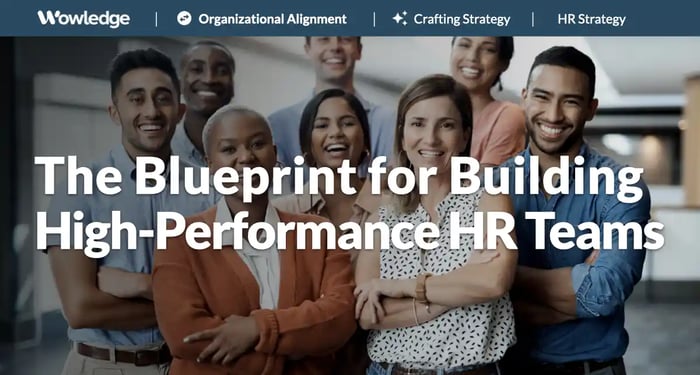Table of Contents
Human resource management strategy is like cake. What? Let me explain.
Many years ago, before my career as an organization design consultant and human resources executive, I was a pastry chef for a lauded fine dining restaurant outside Corning, New York. I learned to make extravagant multi-tiered wedding cakes filled and coated with sweet delights like buttercream frosting, fruit preserves, and custard, then top them with intricate icing decorations. It is typically these things that people remember most about the wedding cake. However, the foundation of a beautiful and delicious wedding cake comes from the cake itself, not all the embellishments. The cake provides the necessary shape, sturdy structure, and base flavor to build upon.
A beautiful and delicious wedding cake doesn’t come together by accident but through purposeful design, careful selection of the components based on the taste and aesthetic preferences of the bride and groom, the number of people it must serve, the number of tiers desired, and the environmental conditions it must withstand. I still have a notebook of sketches and lists to attest to this. Perhaps most importantly, the wedding cake serves the wedding, commemorating the joining of two people, two lives. It’s not just a delicious dessert.
So, I return to my original statement: a human resource management strategy is like cake. A well-crafted HRM strategy is the framework that gives life to the human resources services and programming that employees experience and executives require to run their businesses. Best-in-class HRM strategies are also aligned with and in service of the company’s core values, strategy, and people, not the interests of the HR function itself.
Every company needs an HR management strategy
Talent and organization design can be differentiating sources of competitive advantage for companies. A human resource management strategy is a thoughtful plan that helps ensure a company is focused on the highest value and most urgent activities supporting the health and excellence of its business and people. No matter the size or complexity of the company, all companies should have a plan that captures how they prioritize and invest in their human resources. An HRM strategy does just that.
There are many competing priorities at companies today. Trade-offs about what to spend time and money on have gotten even more difficult. After a robust cycle of corporate growth and capability investment, companies are now in contraction mode, deprioritizing projects, postponing programs and entirely pulling back from planned investments to conserve cash and/or improve operating profits. This forces human resource leaders to make trade-offs within their function and compete for resources with other groups across the company.
Human capital and organizational capability investments can be powerful levers in fueling corporate performance and profitable growth (DiMartino, Planning for Growth: Intentionally fueling your business strategy., September 22, 2023). Ensuring that the HR function and leadership of the corporation are finely tuned to the most critical human capital and organizational work is essential. HR functions and professionals often find themselves over capacity and delivering only average results. HRM strategies create a critical frame for prioritization of business needs, investment, time, and resource deployment, and they articulate how the HR Function and investments add value to the short and long-term needs of the corporation and its people – i.e., the return on investment.
Top C-suite leaders understand the need to balance investments across their business's tangible and intangible facets. They inherently know their talent and organizational effectiveness are crucial elements of their intangible value and essential to business success, even when they cannot put an exact dollar value on them. There is compelling empirical evidence to support this wisdom. Experts in intangible asset valuation, Ocean Tomo, have found intangibles account for 90% of the S&P500 market value, up from 68% in 1995. “Human capability” (talent + leadership + organization + the HR function) may represent as much as 25% of these company intangibles, according to Dave Ulrich and his colleagues at RBL, a leading human capital and HR management advisory firm.
An HR management strategy supports trade-offs
A well-designed HRM strategy is more than just a list of essential activities or an ambitious vision for the future. It is a roadmap that lays out a set of strategic choices about how the HR function and collaborators will and will not support the needs and growth of the business over a specific window of time. It is a selective plan, and, as discussed, it serves as a prioritization guide. As HR budgets and staffing levels shrink, it’s more important than ever for HR professionals to focus on the highest value, most critical work and be able to articulate it crisply to others.
HR professionals are often generous helpers and may struggle to say “no” or “not now” to an internal business client or employee. As a result, there is rampant burnout amongst HR professionals, particularly in the post-Covid era. I have personally witnessed it. An HRM strategy provides the necessary frame for saying “no” or “not now” to exciting and important but less critical work and can reduce the angst many HR professionals feel when saying “no.” Of course, a new request can indeed be high-value and time-sensitive. In these instances, the HRM strategy serves as a foundation from which investment trade-offs can be evaluated—i.e., Which effort or initiative would stop or slow down to make space for a new, more critical priority? What are the comparative merits of one choice over the other? This is an important—and too often skipped—step in the continuous strategic planning cycle. Adding more work to the proverbial plate when resources (budget, time, and expertise) remain constant is a recipe for lackluster HR performance and burnout.

What makes a ‘good’ HR management strategy
HRM strategies should be pragmatic, living documents. This means they have utility in supporting and articulating the following:
1. Aligning global and local interests
2. What is most important and why
3. Driving accountability for results
Aligning Global & Local Interests
Tensions exist in the organization matrix. Indeed, the matrix is designed to create productive tension between the players on its axes—Business Lines, Functions, Geographies, Market Segments—for the benefit of the corporation (Kates, Kesler, DiMartino Networked, Scaled, and Agile: A Design Strategy for Complex Organizations, 2021). And no greater theater exists for this tension to play out than at the budgeting table.
Global corporate functions, such as Human Resources, Finance, IT, Legal, are often caught in the genuine struggle to balance the needs of the corporate enterprise (global) with those of the individual business line, geography, etc. (local), as well the short- versus longer-term needs of the company—i.e., what’s needed in the year-for-the year versus what needs to be started now to deliver on a three year strategy. Both are real dilemmas that global HR functions regularly experience. The reality is that resources are not infinite. There will never be enough resources to do everything and satisfy every executive or unit in the matrix. This is not a woeful tale but a reality that HR professionals often find themselves living and ill-equipped to navigate.
The process of building an HRM strategy can and should be a mechanism for bringing executives together, from across the company, to debate and align around the highest human resource priorities for the company, ideally, using a set of pre-defined decision-making criteria that help ensure a resulting HR portfolio with a mix of local and global, short- and long-term priorities, for a given business cycle. This planning act and the resulting strategy help create the type of aligned leadership support necessary for HR professionals to do their best work for the company and its people without becoming overextended or feeling that they are pleasing no one and disappointing everyone.
What Is Most Important & Why
Once the portfolio of HR priorities has been defined, it must be shared within the HR function and across the company's extended leadership team. Why so broadly? Unlike other corporate functions, Human Resources is viewed as “community property” in many companies. Leaders view themselves as HR experts or at least as deeply accountable for people and teams (a very good thing!) and, therefore, want a say in what types of HR work is done in service of their needs and the needs of their staff.
With this in mind, it is essential to be proactive in sharing the HR priorities of the company (the what), the rationale behind the choices (the why) as well as what HR work is not going to be done, even though it is wanted/needed by some and by all rights is good, meaningful work. A thoughtful communications plan for launching your HRM strategy is essential as you want to create a collective understanding about the HR work that is most important to the company—globally, locally, short- and longer-term. This shared understanding then forms a platform for productive dialogue around the day-to-day prioritization of work and the trade-offs that inevitably surface throughout a given year.
To achieve this, an effective HRM strategy communications plan will seek to convey the following information to its target audiences:
- The human resource priorities of the company
- What services, programs, and initiatives the HR function will be delivering
- How this work will impact employees/managers/executives (their time, work experience, responsibilities)
- Which human resources work will not be done or supported this business cycle
- The intended benefits of the work that will be done, and
- The rationale behind these choices
Driving Accountability for Results
Talk is cheap. Results matter. Most HR organizations are still building muscle around measuring the impact of their efforts and tying them to business benefits. While a company's talent and organizational elements can frequently deliver more intangible benefits at the macro level, specific HR services, programs, and initiatives should have clear outcome measures that ladder up to priority business benefits.
I am a fan of the Kirkpatrick Model for measuring success. As an organization designer, I have modified the model to more broadly apply to measuring changes beyond just training programs. The levels of measurement—reaction, learning, impact/application, and business results—are a valuable way to think about assessing the impact of new HR programs because they account for the degree of change and time-lapse (e.g., individual satisfaction with a program can be measured within days, while business results may not be able to be assessed for months or longer). Both dimensions are critical when measuring change at a group and enterprise level.
Regardless of your measurement framework, your HRM strategy is the right place to capture these commitments to results for the company. This allows for detailed project plans and solution designs to be crafted with the end in mind.
Executives and initiative sponsors owe it to their HR project leaders and project teams to clarify how the success of the program, system, or tool they are working on will be evaluated. This alignment of expectations up front increases the chances that initiative sponsors and beneficiaries will be satisfied with the final product and reduces the chance that frustrating re-work will be needed. Such misalignments can be demotivating to teams and contribute to burnout.
Not to be lost here is that accountability for talent and organization results from HR initiatives often goes well beyond the boundaries of the HR function. Business leaders, managers, and employees frequently have some type of shared accountability for doing something—participating in a program, adopting a new process or tool, exhibiting new behaviors, etc. Given this, communicating intended business results and initiative success measures becomes even more critical.
Back to the cake
Whether a large, well-established global company or a young, regional firm, all companies benefit from having an HRM strategic plan to help ensure that the highest value work is being done in service of the company’s strategy and its people. Of course, the comprehensiveness and breadth of the plan can and should be different based on the size and complexity of the company and its strategic ambitions.
I encourage leaders to take a pragmatic view on the utility and value of an HRM strategy for their company—using it to reconcile divergent HR needs across key stakeholders, articulate what is most important to focus on and why, align expectations and accountability for results, and empower leaders and professionals to make necessary priority trade-offs throughout the business cycle. Remember, your human resource management strategy is the scaffolding—or the sturdy cake—around which you can construct a high-impact human resources ecosystem that generates targeted value for your company.
Relevant Practices & Tools
Core HR Strategy Practices to Define a Foundational Direction for the HR Function. >
An HR Strategy defines the process of identifying business-based human resource (HR) tactics that will constitute a comprehensive multi-year approach to the management of the HR function... more »
Understanding Business Strategies to Align the HR Direction. >
Core to the development of an HR strategy is building an understanding of the key business strategies and initiatives that must be accomplished during the term of the plan... more »
Establishing an HR Organization that Drives the ‘Future of Work’ Across the Business. >
The "Future of Work" is a construct based on three major components - future or forthcoming changes in work method ("what" is done), the makeup of the worker population... more »
Strategic HR Management Explainer: Mastering the Fundamentals. >
Strategic HR Management is a multidimensional approach that seeks to systematically align and optimize an organization’s workforce in support of its business objectives... more »
The HR Business Challenge Goal Conversion Tool: Translate Identified Challenges into Clear and Distinct HR Goals. >
This tool is used in a sequence of analyses that convert key business objectives, external, and internal environmental scans into HR challenges... more »
FAQs
How can HR translate corporate strategy into concrete HR priorities?
Start by isolating the few business capabilities that drive competitive market advantage and mapping their workforce implications across roles, skills, locations, and leadership depth. Use this to identify capability gaps, risks, and time-critical milestones, then convert them into initiatives with clear outcomes. Sequence work by time-to-value and interdependencies with other functions. Validate the draft portfolio with strategy, finance, and business unit/operations leaders to ensure business relevance and funding feasibility.
How should global standards be balanced with local needs in HR?
Define non-negotiable global elements such as data definitions, core process designs, and risk controls that align with the company's mission and values, then allow local configuration where law, labor markets, or business models demand it. Consider the unique needs of value-driving functions and businesses and determine how tailoring can be accomplished without creating unnecessarily inequitable or unfair alterations. Assign clear decision rights so disputes are resolved by role, not hierarchy. Use a design authority to maintain standards and a field council to surface local requirements early. Measure adoption and outcomes to adjust the global/local split over time.
How does an HRM strategy connect to budgeting and goal-setting?
Each initiative should flow directly from primary strategies, and include an owner, cost profile, quarterly milestones, and targeted benefits that align with the financial plan and leadership objectives. Align deliverables with the corporate OKR or KPI cycle so progress is reviewed alongside business results. Maintain a rolling 12–18 month roadmap that informs funding gates and vendor commitments. Variances in cost or impact should trigger governance discussions, not ad hoc workarounds.
What governance model drives accountability for results, not just activity?
Create a small steering group of business, finance, and HR leaders that meets on a fixed cadence to approve priorities, remove roadblocks, and review outcomes. Use a responsibility assignment matrix (aka RACI chart) to clarify who sponsors, who owns delivery, and which line leaders must adopt and sustain the change. Tie leader scorecards to adoption and impact metrics, not training completions or communications volume. Sunsetting rules should retire low-value work to free capacity.










